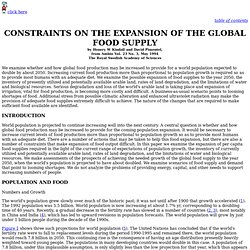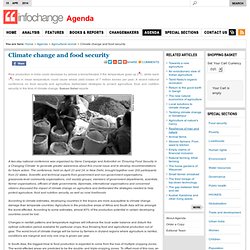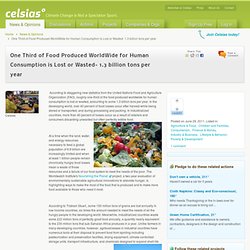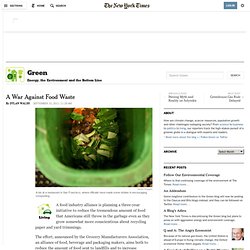

Bob_Positive_Activism. CONSTRAINTS ON THE EXPANSION OF THE GLOBAL FOOD SUPPLY. Click here table of contents We examine whether and how global food production may be increased to provide for a world population expected to double by about 2050.

Increasing current food production more than proportional to population growth is required so as to provide most humans with an adequate diet. India - Agriculture. India Table of Contents AGRICULTURE HAS ALWAYS BEEN INDIA'S most important economic sector.

In the mid-1990s, it provides approximately one-third of the gross domestic product (GDP--see Glossary) and employs roughly two-thirds of the population. Since independence in 1947, the share of agriculture in the GDP has declined in comparison to the growth of the industrial and services sectors. However, agriculture still provides the bulk of wage goods required by the nonagricultural sector as well as numerous raw materials for industry. Moreover, the direct share of agricultural and allied sectors in total exports is around 18 percent. Dependence on agricultural imports in the early 1960s convinced planners that India's growing population, as well as concerns about national independence, security, and political stability, required self-sufficiency in food production.
Land Use In FY 1987, field crops were planted on about 45 percent of the total land mass of India. InfoChange India News & Features development news India - Climate change and food security. Rice production in India could decrease by almost a tonne/hectare if the temperature goes up 20C, while each 10C rise in mean temperature could cause wheat yield losses of 7 million tonnes per year.

A recent national conference on food security and agriculture deliberated strategies to protect agriculture, food and nutrition security in the time of climate change. Suman Sahai reports A two-day national conference was organised by Gene Campaign and ActionAid on ‘Ensuring Food Security in a Changing Climate’ to generate greater awareness about this crucial issue and to develop recommendations for future action. The conference, held on April 23 and 24, in New Delhi, brought together over 200 participants from 22 states.
According to climate estimates, developing countries in the tropics are more susceptible to climate change damage than temperate countries. One-third of the world's food goes to waste, says FAO. A Filipino scavenger collects food waste from a market in Manila, Philippines.

UN food agency stunner: World loses one-third of total global food production. By Climate Guest Contributor on May 23, 2011 at 12:34 pm "UN food agency stunner: World loses one-third of total global food production" Bloom: “2% of all US energy goes to food we’re throwing away.”

Figure 2 shows that the per capita food loss in Europe and North-America is 280-300 kg/year. One Third of Food Produced WorldWide for Human Consumption is Lost or Wasted- 1.3 billion tons per year. According to staggering new statistics from the United Nations Food and Agriculture Organization (FAO), roughly one-third of the food produced worldwide for human consumption is lost or wasted, amounting to some 1.3 billion tons per year.

In the developing world, over 40 percent of food losses occur after harvest-while being stored or transported, and during processing and packing. In industrialized countries, more than 40 percent of losses occur as a result of retailers and consumers discarding unwanted but often perfectly edible food. Wasting Food = Wasting Water. Inside a dumpster.

Photo credit: sporkist The world is teetering on the edge of a food crisis due to the growing population, soaring food prices, and water scarcity, yet a shocking one third of the food produced around the world goes to waste. A new report by the Food and Agriculture Organization of the United Nations (FAO) found that 1.3 billion tons of food are lost each year, which means that the resources used to produce that food are also lost. “As much as half of the water used to grow food globally may be lost or wasted,” said Dr. A War Against Food Waste. Getty ImagesA bin at a restaurant in San Francisco, where officials have made some strides in encouraging composting.

A food industry alliance is planning a three-year initiative to reduce the tremendous amount of food that Americans still throw in the garbage even as they grow somewhat more conscientious about recycling paper and yard trimmings. The effort, announced by the Grocery Manufacturers Association, an alliance of food, beverage and packaging makers, aims both to reduce the amount of food sent to landfills and to increase donations to food banks for the poor. One Country’s Table Scraps, Another Country’s Meal. Elimination of food waste could lift 1bn out of hunger, say campaigners. Half of US food goes to waste. As the US celebrates Thanksgiving, a new study reveals that almost half the food in the country goes to waste - a statistic that should alarm an industry that is struggling to achieve greater efficiency in order to salvage profits.

The new study, from the University of Arizona (UA) in Tucson, indicates that a shocking forty to fifty per cent of all food ready for harvest never gets eaten. Timothy Jones, an anthropologist at the UA Bureau of Applied Research in Anthropology, has spent the last 10 years measuring food loss, including the last eight under a grant from the US department of agriculture (USDA). Jones started examining practices in farms and orchards, before going onto food production, retail, consumption and waste disposal. What is soil degradation. Soil degradation is when soil deteriorates because of human activity and loses its quality and productivity.

It happens when soil loses its nutrients, or its organic matter. It also happens when the soil structure breaks down, or if the soil becomes toxic from pollution. The primary cause of soil degradation is erosion, but compaction, salinization, and depletion by nutrient demanding crops may also cause degradation. Soil degradation. Soil degradation.
Soil degradation is the decline in soil quality caused by its improper use, usually for agricultural, pastural, industrial or urban purposes. Soil degradation is a serious global environmental problem and may be exacerbated by climate change. It encompasses physical, chemical and biological deterioration. The lowdown on topsoil: It's disappearing. Photo: Andy Rogers/Seattle Post-Intelligencer John Aeschliman shows a spot where rain has washed soil from a neighboring farmer's property onto the road.
Aeschliman says his method of farming, in which plants are seeded directly into the remains of the previous crop without tilling, gives stability to the soil, enabling it to retain water and preserve the organic matter within it. less John Aeschliman shows a spot where rain has washed soil from a neighboring farmer's property onto the road. Soil erosion and crop productivity: topsoil thickness. The effect of soil erosion can be partitioned into costs to the actual site where erosion takes place and costs off site where sediment contributes to water quality problems.
The on-site costs can include loss in production potential due to deterioration in soil physical and chemical properties such as infiltration rate, water holding capacity, loss of nutrients needed for crop production, and loss of soil carbon. Civilization and Topsoil: Erosion Around the World. Culture Published on September 29th, 2010 | by Earth Policy Institute By Lester R. Brown The thin layer of topsoil that covers the planet’s land surface is the foundation of civilization.
This soil, typically 6 inches or so deep, was formed over long stretches of geological time as new soil formation exceeded the natural rate of erosion. This is not new. Saving Our Precious Topsoil by Shawn Dell Joyce on Creators. In our culture, "dirt" is a derogatory term, like "dirt poor," "dirty" or "soiled. " Save The Environment: How What You Eat Changes The World.
Urban Sprawl: the Big Picture. Family Farms, why family farms important - The Issues. Future Food Qld. Agricultural land resources are important to Queensland. Warning about farmland lost to development. U.S. population growth is a key factor in paving the world’s breadbasket. Bye Bye, Virginia Farmland - Hello, McDonalds? Sprawl momentum builds in Central Saanich. By Gordon O'Conner, February 2011 Proposals to extend municipal water services suggest the municipality is being primed for real estate development. On a continent where big box stores and parking lots have buried farmland and choked the rivers next to almost every major city, Central Saanich has been a shining example of progressive land use planning.
It is a bucolic paradise of farms, open fields, rolling hills and ocean views that sits less than 30 minutes outside downtown Victoria. Unfortunately, all of this open land and beautiful scenery make it the perfect candidate to become another drab commuter subdivision. What to Do About Rural Sprawl? Loss and Fragmentation of Farmland. Executive summary | Acknowledgements The "Loss & Fragmentation of Farmland" report looks at the extent to which farm and ranchlands in Alberta were converted to other uses for the period of 1997 to 1998. AGRICULTURE AND ORGANIC FARMING IN CHINA. Rural Legacy Program - Land Acquisition and Planning - Maryland Department of Natural Resources. Fragmenting rural land. Urban Sprawl @ nationalgeographic.com. What is Urban Sprawl? TEACH: Urban Sprawl in the Great Lakes Region.
Greenbelt Ontario - Urban Sprawl. A comprehensive look at sprawl in America. Urban sprawl - in pictures. Loss of Agricultural Capacity Due to Urban Sprawl. Prince of Wales says urban sprawl is the 'greatest challenge' facing planners. Britain From Above - Stories - Building Britain - Urban Sprawl. Dead Malls dot Com: Feature: Dixie Square Mall: Harvey, IL.
Ghost mall: The world's largest (and loneliest) shopping centre. The Ghosts of Shopping Past: Abandoned malls and big-box stores. Ghosts of Shopping Past. Abandoned Rolling Acres Mall, Rolling Acres/Akron, Ohio Footage 2009. Abandoned mall in Chicago. Dawn Of The Dead Malls. Abandoned Malls, Suburban Blight.